Good and Bad abdominal exercises!
If you read our blog regularly, you already know “classic” abdominal exercises like crunches and sit up are bad for your pelvic floor, back and abdomen as they increase intra-abdominal pressure. Today will see in details why these exercises are harmful and how to perform safe abdominal exercises! This increase of intra-abdominal pressure is obvious when you perform these exercises as you can see your belly bulging upward. It will have various negative effects:Harm your abdominal muscles!
It is easy to understand how on a long term these exercises slowly stretch your rectus abdominis (6 packs muscles) and create a gap in the middle. This gap is named a diastasis, for more details look at our previous article on abdominal rehabilitation.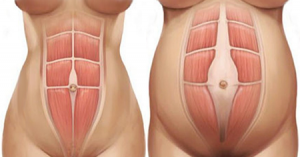
Harm your pelvic floor muscles!
However, this abdominal push is only the tip of the iceberg. A similar push is created downward on your pelvic floor muscles (see this previous post for more details but as a quick reminder, pelvic floor need to raise to hold your organs in place and not be push downward…). As a consequence, your pelvic floor muscles are also stretched and weakened by exercises increasing your intra-abdominal pressure. To summarise: NO, crunch and sit up won’t help you to have a flat belly or even less to lose belly fat! YES, they will stretch and weaken your pelvic floor and abdominal muscles potentially leading to urinary / anal incontinence, prolapse, haemorrhoid and pelvic pain…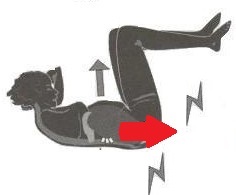
How to recognize bad abdominal exercises?!?
Main advice: pay attention at your belly! If it bulges it is wrong… Some exercises are problematic by essence: Any exercise involving raising your head or legs (or even worst: both…) because you won’t be able to perform them without drastically increasing your intra-abdominal pressure (big belly bulge) But even “good” abdominal exercises performed wrongly also have the potential to increase intra-abdominal pressure and be harmful! In any abdominal exercise if you notice your abdomen bulging, it means increase abdominal pressure! This includes core exercise (plank), Pilates, yoga, physiotherapy exercises and even the one we advised in previous blog post. Let’s see some example of “bad” dangerous abdominal exercise: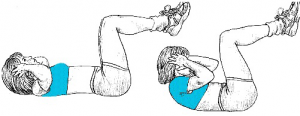
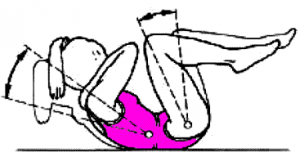
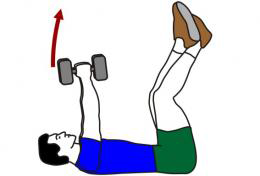
Even worst, kettle belt and other weight… This is a really bad idea after childbirth or with a weak pelvic floor. It will increase even more your intra-abdominal pressure.
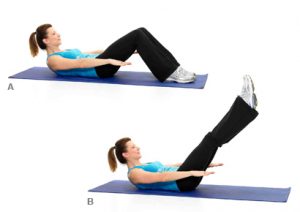
Yes, this last exercise commonly uses in Pilates, is also problematic and can be harmful if performed wrongly or too soon after you gave birth!
Just to avoid any misunderstanding, we are not condemning Pilates as whole and have no issue to refer our patients to Pilates instructor. But some exercises can be harmful especially after pregnancy. Pilates as any physical activity is only safe if performed correctly. And yes, we had several cases of new mom harming themselves practicing Pilates incorrectly… So be sure your instructor is properly trained particularly for post-natal classes…How to train your abdominal muscles correctly?
If you gave birth recently or suffer from diastasis, urinary / anal issues please have a look at our previous article. For the others, keep in mind what we said previously: your belly must not bulge! If it is the case, you either performing the exercise wrongly or your transverse abdominis is too weak and you can look at this article to retrain it.5 safe abdominal exercises!
They are in increasing difficulty order, with the easiest first. For any of these exercises, if you feel you can’t prevent your belly bulging, go back to the previous exercise until you able to perform the next one correctly. For all of them there are general guidelines to follow:- Back is always straight, shoulder lowered and slightly backward
- Breathe in freely
- Breathe out through the mouth bringing your belly in (as you were putting on a jean too tight) then tilt your pelvis backward
- Engage your pelvic floor muscles on each exhalation
- Any movement would happen in exhalation to avoid any belly bulging and to keep your pelvis in a neutral position
- In inhalation you maintain your posture but you are not moving
#1 Bridge
- As you breathe out (belly in and tilting your pelvis backward), engage your pelvic floor muscles, then raise your buttock for 30cm (not too far to avoid to arch your back)
- Still breathing out, raise one leg
- Rest the leg on the ball again as you breathe in
- Breathe out again to raise the other leg
- Rest this leg on the ball as you breathe in
- Finally, as you breathe out, rest your buttock on the floor still avoiding to arch your back
#2 Superman
- On all four
- As you breathe out, raise one arm and the opposite leg
- Careful! Avoid to lower your hip on the side you are raising the leg and keep you’re a back completely flat
- Breathe in as you keep the posture
- Breathe out as put your hand and leg on the floor
#3 Plank on all four
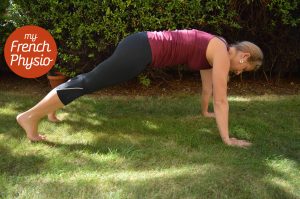
- Warning! This exercises is more difficult and if your transverse muscle is not strong enough your belly may bulge… In this case, continue practicing the previous one and try 3# exercise again next week!
- Raise your bottom high enough to have a flat back as you breathe out
- Raise one leg as you breathe out
- Put it down as you breathe in
- Repeat on the other side
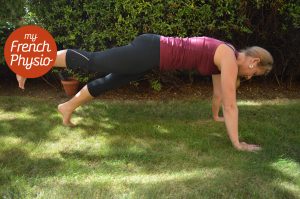
#4 Side plank
- Breathe out as you push on your hand and feet to raise your legs hips and trunk
- Raise your arm above your neither forward or backward
- Breathe in maintaining the position
- Go back on the floor as your breathe out
#5 Mountain climbing
- On all four
- As your breathe out raise both of your knee
- Breathe in keeping the position
- Raise your foot and then bring your knee in toward opposite shoulder as you breathe out
- Put your foot down as you breathe in
- Repeat 5 times on each side



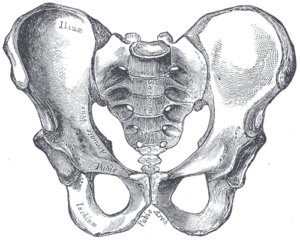
5 Responses
Hello, I am new to your articles. I was just wondering if this article applies only to women after giving birth. Or, more broadly, if one has a pelvic floor issue. I have to lift a lot for my job, which, i am thinking, any lifting, probably, makes the belly bulge. As well as if I simply bent over. Are these things bad?
Hi Rachel, this article applies especially for women after giving birth and at menopause, as the pelvic floor is particularly weak at these periods of life. But it also applies more broadly for women with pelvic floor issues.
Lifting is not an issue in itself. If you follow ergonomic recommendations (such as staying close to the weight, bending your knees not your back, etc.) and you engage your abdominal transverse muscle with your pelvic floor muscles you won’t have any problem to manage the extra intra abdominal pressure and no abdominal bulge should appears.
If you are worried your abdominal or pelvic floor muscles are too weak don’t hesitate to see a women’s health physiotherapist and start adapted exercises.
*Post Edit* Please delete my previous post.
Hi Virgil,
I am a Classical Hatha Yoga teacher. Thank you for your blog post. You have made a lot of interesting points. When I took the teacher trainer course we were never told that intra-abdominal pressure was a bad thing. Intra-abdominal pressure was listed as a benefit to doing specific yoga postures.
I am aware that there are some yoga postures that not only cause an increase in intra-abdominal pressure but cause EXTREME intra-abdominal pressure. One pose in particular is Dhanurvakrasna (The Bow Curve Pose). This is a prone position asana, which makes it hard to feel the “belly bulge” you are referring to. It is also very hard to concentrate on that part of your body while you are trying to execute the pose as it is a more advanced pose. The object is balancing on the naval while trying to assume a somewhat circular position. Some of the benefits of doing this posture are increase in thoracic activity, contraction and relaxation of spinal muscles particularly on the sacral end, increase in blood supply to the abdominal viscera, lower abdomen and sex organs. This posture is not to be performed by people who are pregnant or postpartum. I do not fall in this category and neither do my clients. This is something to keep in mind for the future.
There are of course other asanas which are far more gentler but still cause an increase in intra-abdominal pressure. These other postures tend to be very helpful for people with Diabetes and heart conditions.
I am wondering what is your take on yoga, particularly prone position postures.
What exercises do u recommend after having had surgery for inguinal hernia three times
Hi,
Can I do these exercise if I am diagnosed with urachal cyst infection one month back? I am also 2 months postpartum.
Thank you